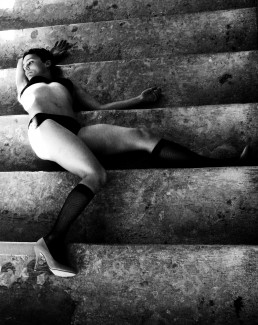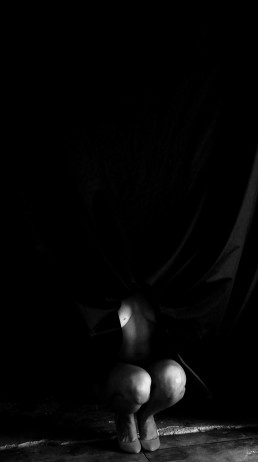“THERE’S NO WORLD WHEN THERE IS NO MIRROR”
Ana Rito
« Donnez-moi donc un corps. »
Deleuze
A artista visual portuguesa Ana Rito (Lisboa, 1978) apresenta pela primeira vez uma nova série de vídeo-instalações e filmes finalizados na residência artística no Carpe Diem – Arte e Pesquisa, antigo Palácio Pombal, em Lisboa. Prosseguindo com a linha orientadora de obras anteriores (Encore, Museu Coleção Berardo, Lisboa, Puppe Project, Mario Mauroner Contemporary Art, Viena) caracterizadora do seu trabalho, a artista explora a complexidade do corpo-cinema deleuziano e as suas possibilidades enquanto imagem afetada pela dimensão temporal, proto/pseudo narrativa, psicológica e instalativa. Fazendo do happening e da performance matéria primordial de reflexão, utiliza o vídeo como meio operativo que possibilita o entendimento do corpo (feminino) enquanto corpo-político, no qual os gestos e poses tendem, numa referência a Godard, a construir as atitudes da carne como categorias do espírito.
Na exposição individual There is no world when there is no mirror, que se instala no mesmo espaço físico onde as obras foram terminadas, é apresentado um conjunto de momentos que poderíamos considerar aqui de para-videográficos, caracterizados pelo tom cerimonioso e litúrgico de duas personagens femininas que insistentemente coabitam o espaço. Tendo como referência o happening Koncert Morski, 1967, de Tadeusz Kantor, Rito concebe Semi-Panoramic Sea Concert (2010), uma nova vídeo-instalação, para a antiga cozinha do Palácio Pombal. Nesta peça, uma personagem feminina “recria” o concerto ao mar num ritual de gestos e repetições hipnóticas que redimensionam a obra do autor polaco. Para a artista, Kantor é uma figura incontornável do panorama europeu no que concerne ao trabalho sobre a performance, o happening e mesmo o teatro nos seus diversos cruzamentos com as artes visuais. Em Semi-Panoramic Sea Concert (2010) assistimos a uma primeira incursão que utiliza a rodagem em exterior como lugar do acontecimento, e, numa perspetiva neorromântica dimensionável do homem perante a natureza, transporta o corpo da performer do espaço arquitetural para o espaço “lá fora”, conseguindo refletir no exterior a dimensão interiorizável do eu.
As obras Horseback (2010) e Théâtre Privé (2010) problematizam o enquadramento do gesto, desta feita utilizando uma das salas do Palácio Pombal como elemento cénico habitável constituído por atitudes e lugares. Para a autora, é o gesto que acorda o corpo e não o corpo que dá vida ao gesto. Segundo Carlos Vidal, as obras videográficas e as obras fotográficas de Ana Rito confluem para uma “pura teatralidade”, e é esse elemento estilizável, essa fluctuatio animi de que falou Spinoza, que caracteriza estas obras e este projeto no seu todo.
Assim, em Horseback (2010) vemos duas mulheres que percorrem um conjunto de salas. Deslocam-se vagarosamente, sendo que uma delas, de joelhos, carrega às costas a outra que fita o espetador durante toda a cena. Em Théâtre Privé (2010) uma figura feminina não chega a entrar numa sala, que depreendemos ser o nosso local de observadores. Apenas se apresenta, espera um pouco e retira-se. Neste conjunto de estados e permanências, quasi solilóquios corporais, pode mesmo referir-se Deleuze quando descreve a noção da encenação e da pose no cinema como gestos não reais e não imaginários, mas algo entre os dois mundos, uma espécie de teatralização da imagem que se diferencia do aspeto canónico do teatro mais ortodoxo. Salientaríamos também a obra Innuendo (2010), onde assistimos a uma coreografia realizada por uma personagem que utiliza uma cortina como constrangimento físico, limitativo dos movimentos que procura realizar sem sair do mesmo sítio.
Importa finalizar com uma referência a Bruce Nauman, quando explora a repetição e o cansaço ou fadiga na procura do gesto que ilustra uma ideia de transgressão, mas também de unificação entre o espaço circundante e o limite do corpo, seja em torno do perímetro de um quadrado, seja a ocupação de uma arquitetura pombalina.
A exposição There is no world when there is no mirror é concebida, pois, como um reflexo, um reflexo que devolve o olhar dialético entre a imagem e a sua ausência, dois extremos sempre presentes no trabalho videográfico de Ana Rito.
Hugo Barata
Ficha técnica
Performers Sophie Leso e Rita Lucas Coelho
Conceção e Direção artística Ana Rito
Duração 50 minutos
Apoio Fundação Calouste Gulbenkian
“THERE’S NO WORLD WHEN THERE IS NO MIRROR”
Ana Rito
« Donnez-moi donc un corps. »
Deleuze
The Portuguese visual artist, Ana Rito (Lisbon, 1978), presents, for the first time, a new series of video-installations and films which were completed in the artist’s residence at Carpe Diem – Arte e Pesquisa, located in the Pombal Palace in Lisbon. Continuing on with the same direction line of previous works (Encore, Museu Coleção Berardo, Lisbon, and, Puppe Project, Mario Mauroner Contemporary Art, Vienna), characteristic of her work, the artist explores the complexity of the Deleuzian cinema-body and its possibilities of being an image that is affected by the temporal dimension, the proto/pseudo narrative, as psychological and installative. Creating material for reflection based on the happening and the performance, she uses video as an effective mean to enable the understanding of the (feminine) body as a political-body, to which the gestures and poses are inclined, in reference to Godard, to construct the attitudes of the flesh as categories of the spirit.
In the exhibition There is no world when there is no the mirror, which has been installed in the same physical space where the works were completed, a set/an ensemble of moments are presented which we could consider as para-videographics, characterized by the ceremonious and liturgical tone of two female characters who persistently co-inhabit the space. Having as a reference the happening Koncert Morski, 1967, by Tadeusz Kantor, Rito conceives Semi-Panoramic Sea Concert (2010), a new video-installation, for the antiquated kitchen of the Pombal Palace. In this show, a female character “recreates” the sea concert in a ritual of gestures and hypnotic repetitions which resize the work of the Polish author. To the artist, Kantor is an outstanding figure of the European outlook concerning his work on performance and theatre in his various links to the visual arts. In Semi-panoramic Sea Concert (2010) we witness a first incursion which uses filming outside as the place of activity, and, in a neo-romantic, dimensional perspective of man before nature, it transports the perforner’s body from the architectural space to the space “out there”, able to reflect outside the internal dimension of the self.
The works Horseback (2010) and Théâtre Privé (2010) problematize the gesture’s framing, therefore using one of the rooms of the Pombal Palace as a habitable scenic element constituted by attitudes and places. For the author, it is the gesture which awakens the body and not the body which gives life to the gesture. According to Carlos Vidal, the video and photographic artworks of Ana Rito converge towards a “pure theatricalism”, and it is that stylized element, that “fluctuatio animi” of Spinoza, which completely characterizes these works and this project overall.
Therefore, in Horseback (2010) we see two women moving across a series of rooms. They move slowly. One of them carries the other on her back by her knees, while the other one captures the interest of the spectator during the whole scene. In Théâtre Privé (2010), a female figure is unable to enter a room, which we perceive to be our place of observation. She only presents herself, waits a short time, and then bows out. In this set of states and visits, which are almost corporal soliloquies, it could equally make reference to Deleuze when it describes the notion of staging and the cinema pose as gestures that are not illusory and not real, but rather as something between the two worlds, a type of dramatization of the image which is differentiated from the canonical aspect of the most orthodox theatre. We would also emphasize the work Innuendo (2010), where we witness a choreography performed by a character who uses a curtain as a physical constraint, limiting the movements that she wishes to carry-out, without moving from the same place.
It is relevant to conclude with a reference to Bruce Nauman, where he explores the repetition, the fatigue or the tiredness, in the search for the gesture which illustrates the idea of transgression, but also of unification between the surrounding space and the corporal limit, around the perimeter of a square, or even in the occupation of a building with Pombaline architecture.
The exhibition There is no world when there is no mirror is conceived, therefore, as a reflection, a reflection that returns the dialectic eye between the image and its absence, two extremes which are always present in Ana Rito’s video work.
Hugo Barata
Credits
Performers Sophie Leso and Rita Lucas Coelho
Concept and Artistic direction Ana Rito
Lenght 50 minutes
Support Fundação Calouste Gulbenkian

